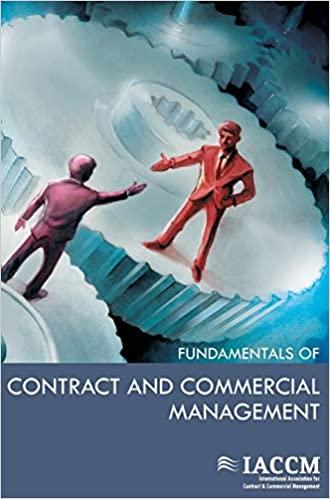Question
You have been assigned as the PM for a new project, today on Oct 5, 2022. Due Date Oct 19, 2022 11:59 PM. Here is
You have been assigned as the PM for a new project, today on Oct 5, 2022. Due Date
Oct 19, 2022 11:59 PM.
Here is the information you have been given to get you started:
- Due to COVID19, the government has mandated that all companies regardless of their size, must give their customers the option to make their payments online using debit or credit. The legal department is the project initiator but will require involvement of many teams including subject matter experts and government liaison to define the requirements.
- You are an independent company providing propane to local rural areas.
- You have an online website but currently customers only have the option to have auto withdrawals from their bank account or pay their monthly invoice via cheque or as a payee in their bank account. Therefore, a new module needs to be added to the website for a customer portal that each customer will need to setup and sign into with an ID and password. Banking or Credit information will also need to be encrypted.
- The initial budget +-50% is $100,000.
- The government has mandated that this be available to customers by Jan 1, 2023.
- Given what you know so far document the following (you may not have all the information you need to complete everything but you can make assumptions by documenting them and what steps you need to take to get the information you need):
- Choose one of the 3 SDLC models and explain why you have chosen it for this particular project.
Introduction
The chosen SDLC approach is the Hybrid model. Let's understand why below.
Assumptions
Based on the information available, five assumptions can be made about the client's profile and the project's requirements.
- The client is not too experienced with IT solutions and IT development. This can be assumed from their business profile ('independent company providing propane to local rural areas') and the current features of their online service (just a basic website with no online payment solutions).
- Because of not being experienced with tech solutions, the client may not know exactly all they want. And by this it is meant that even though the requirements by the government are clear (online payment by debit and credit card by Jan 1 2023) there are a myriad of possibilities for this feature's functionality and look-and-feel.
- It is assumed that because of this unfamiliarity with tech solutions, a top-down analysis will be made in order to extract the requirements the client has in mind. However, engaging them in the process of development since the beginning is crucial to ensure the best possible outcome for the product.
- It is also assumed that the client does not have an IT department in their organization, and so they will procure the solution with a consulting company or service provider who would probably make use of ready-made solutions like a whitelabel for agility and cost reasons.
- The last important assumption is that because the client is from a traditional industry (gas), they may feel more comfortable with a degree of predictability, like a baseline cost. In addition, the government requirements stipulate a rigid deadline, which also acts as an important constraint.
Why Hybrid?
With these assumptions in mind, the hybrid of predictive and adaptive approaches seem more appropriate for this project. The rationale is as follows:
- Payment solutions that have to be integrated across systems owned by different companies may present integration challenges. Therefore, the requirements of implementing an online solution for encrypted debit/credit card payments may not be as predictable and straightforward and some degree of flexibility is required. This is not a strength of the waterfall model, for instance, but it is of adaptive approaches.
- In addition, an adaptive approach (such as Agile) allows the customer to engage with the solution's development and discover how 'perfect' they wish the final product to be (because the sky is always the limit). For instance, if the performance of a transaction is taking a little longer than what users may expect from other online shops and this delay is a performance issue on their server's side, is that something to be reworked further? Or is the client satisfied with the performance (given the deadline/budget constraints)? Another instance: what functionalities/look-and-feel are they prepared to pay for or compromise to keep the project within schedule/budget? Flexibility and client engagement in this scenario is beneficial and an adaptive approach can provide that.
- Lastly, being the client's profile more traditional, they may be more comfortable with a clear baseline of costs and a deadline common in tradicional predictive models. Therefore, a mix of both predictive and adaptive SDLC models seems to be better suited for this project.
- Using the 5 phases identified by PMI, list what tasks would be performed in each phase and who you would be performing that task (example: business requirements would be documented by a business analyst). ?
Step by Step Solution
There are 3 Steps involved in it
Step: 1

Get Instant Access to Expert-Tailored Solutions
See step-by-step solutions with expert insights and AI powered tools for academic success
Step: 2

Step: 3

Ace Your Homework with AI
Get the answers you need in no time with our AI-driven, step-by-step assistance
Get Started


